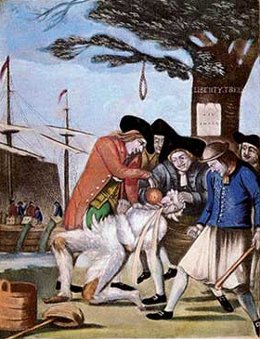I gave some examples of attacks directed at tax offices, and I gave some further examples of attacks on the apparatus of taxation. Today I’m going to give some examples of how some tax resistance campaigns have used particularly humiliating violent attacks against individual tax collectors in the course of their campaigns.
- The textbook case of humiliation-attacks on tax collectors is the “tarring and feathering” practiced, in particular, by American revolutionaries.
After the revolution, the Whiskey Rebels took up the practice.
In one case:
On other occasions, the rebels “docked [collectors’] horses’ tails, and in at least one instance tarred a collector and rolled him in leaves.” One process server “was seized, whipped, tarred and feathered, and after having his money and horse taken from him, was blindfolded and tied in the woods, in which condition he remained five hours.”A party of men, armed and disguised, waylaid [Robert Johnson, collector of the revenues] at a place on Pidgeon Creek, in Washington County, seized, tarred and feathered him, cut off his hair, and deprived him of his horse, obliging him to travel on foot a considerable distance in that mortifying and painful situation.
A delusional man named Wilson, “manifestly disordered in his intellects, imagining himself to be a collector of the revenue, or invested with some trust in relation to it, was so unlucky as to make inquiries concerning distillers who had entered their stills, giving out that he was to travel through the United States, to ascertain and report to Congress the number of stills, etc. This man was pursued by a party in disguise, taken out of his bed, carried about five miles back to a smith’s shop, stripped of his clothes, which were afterwards burnt, and, after having been himself inhumanly burnt in several places with a heated iron, was tarred and feathered, and about daylight dismissed — naked, wounded, and otherwise in a very suffering condition.” - Violent humiliation attacks known as “carding” were also part of the Tithe War in Ireland.
According to one account:
Carding the tithe proctors (who certainly were the genuine tyrants of Ireland) was occasionally resorted to by the White Boys, and was performed in the following manner. The tithe proctor was generally waked out of his first sleep by his door being smashed in; and the boys in white shirts desired him “never to fear,” as they only intended to card him this bout for taking a quarter instead of a tenth from every poor man in the parish. They then turned him on his face upon the bed; and taking a lively ram cat out of a bag which they brought with them, they set the cat between the proctor’s shoulders. The beast, being nearly as much terrified as the proctor, would endeavour to get off; but being held fast by the tail, he intrenched every claw deep in the proctor’s back, in order to keep up a firm resistance to the White Boys. The more the tail was pulled back, the more the ram cat tried to go forward; at length, when he had, as he conceived, made his possession quite secure, main force convinced him to the contrary, and that if he kept his hold, he must lose his tail. So, he was dragged backward to the proctor’s loins, grappling at every pull, and bringing away, here and there, strips of the proctor’s skin, to prove the pertinacity of his defence. When the ram cat had got down to the loins, he was once more placed at the shoulders, and again carded the proctor (toties quoties) according to his sentence.
- In , “An irate dry cleaner” named LaSaunders Hudson “who wouldn’t pay his taxes forced three state revenue agents to march naked out of his store”
Mabile said as the agents were removing their underwear, Hudson advised them that “this is part of the punishment we are going to give the white man for injustices done the black man.”
- During the salt tax (gabelle) riots in Bordeaux in , “A few tax collectors were killed. Their bodies were dragged through the streets and covered in heaps of salt to underline the point.”
- In , Irish settlers in Canada who were refusing to pay a county tax there were confronted by a deputy sheriff who had intended to seize property for back taxes. Instead, “they compelled him to eat the writs he had, and then gave him a limited time to get out of the township.”
- In one town, in the aftermath of the French Revolution, “the moment the clerk begins to read the document, the women spring upon him, seize the tax-roll, and ‘tear it up with countless imprecations;’ the municipal council is assailed, and two hundred persons stone its members, one of whom is thrown down, has his head shaved, and is promenaded through the village in derision.”
Sometimes the humiliation attack would be performed on the tax collector in absentia or in effigy:
- During the Tithe War in Ireland, resisters
audaciously dug a grave within sight of Dinefwr Castle, the family seat, and announced that [Colonel George Rice] Trevor would occupy it by . Trevor, however, surrounded by soldiers, survived unscathed.
- During the Whiskey Rebellion,
[T]he inspector of the revenue was burnt in effigy in Allegany county, at a place, and on a day, of some public election, with much display, and without interruption, in the presence of magistrates and other public officers.

